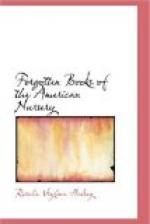It was in Philadelphia that one of the first, if not the first children’s library was incorporated in 1827 as the Apprentices’ Library. Eleven years later this library contained more than two thousand books, and had seven hundred children as patrons. The catalogue of that year is indicative of the prevalence of the Sunday-school book. “Adventures of Lot” precedes the “Affectionate Daughter-in-Law,” which is followed by “Anecdotes of Christian Missions” and “An Alarm to Unconverted Sinners.” Turning the yellowed pages, we find “Hannah Swanton, the Casco Captive,” histories of Bible worthies, the “Infidel Class,” “Little Deceiver Reclaimed,” “Letters to Little Children,” “Juvenile Piety,” and “Julianna Oakley.” The bookish child of this decade could not escape from the “Reformed Family” and the consumptive little Christian, except by taking refuge in the parents’ novels, collections of the British poets and essayists, and the constantly increasing American writings for adults. Perhaps in this way the Sunday-school books may be counted among that long list of such things as are commonly called blessings in disguise.
[Illustration: A Child and her Doll]
Aside from the strictly religious tale, the contents of the now considerable output of Harper and Brothers, Mahlon Day, Samuel Wood and Sons of New York; Cottons and Barnard, Lincoln and Edmunds, Lilly, Wait and Company, Munroe and Francis of Boston; Matthew Carey, Conrad and Parsons, Morgan and Sons, and Thomas T. Ashe of Philadelphia—to mention but a few of the publishers of juvenile novelties—are convincing proof that booksellers catered to the demand for stories with a strong religious bias. The “New York Weekly,” indeed, called attention to Day’s books as “maintaining an unbroken tendency to virtue and piety.”
When not impossibly pious, these children of anonymous fiction were either insufferable prigs with a steel moral code, or so ill-bred as to be equally impossible and unnatural. The favorite plan of their creators was to follow Miss Edgeworth’s device of contrasting the good and naughty infant. The children, too, were often cousins: one, for example, was the son of a gentleman who in his choice of a wife was influenced by strict religious principles; the other boy inherited his disposition from his mother, a lady of bland manners and fine external appearance, but who failed to establish in her offspring “correct principles of virtue, religion, and morality.” The author paused at this point in the narrative to discuss the frailties of the lady, before resuming its slender thread. Who to-day could wade through with children the good-goody books of that generation?




